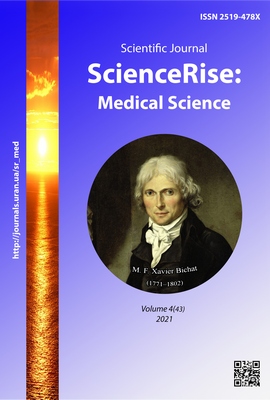Implementation of mini-invasive methods of bile drainage in the treatment of blastomatous mechanical jaundice
DOI:
https://doi.org/10.15587/2519-4798.2021.237931Keywords:
blastomatous mechanical jaundice, minimally invasive treatment, antegrade and retrograde methods of choledochal drainageAbstract
Tumor diseases of the BPDZ (biliopancreatoduodenal zone) occupy one of the leading places among the causes of disability and mortality of the population, both according to global and domestic statistics, while in 85–90 % of cases, patients with distal tumor biliary obstruction are detected. The most common symptom of malignant tumors of periampullary localization is OJ(obstructive jaundice), which is found in 86–95 % of patients and becomes the first manifestation of the disease in 65–70 % of cases.
Purpose. Optimization of surgical treatment in surgically incurable patients with obstructive blastomatous jaundice.
Materials and methods. The study was clinical in nature, it was carried out on the basis of CCH №17 (Kharkov, Ukraine) and the State Institution “Institute of General and Emergency Surgery named after V. I. Zaitsev National Academy of Medical Sciences of Ukraine ") and consisted of two stages. The main task of the first stage was a retrospective assessment of the results of antegrade and retrograde minimally invasive interventions performed in the period from 2006 to 2011 in 122 patients. The main objective of the second stage of the study was to assess the results of surgical treatment of 75 patients with blastomatous breast, who were treated from 2012 to 2019. using the developed treatment algorithm.
Results. At the first stage of the study, the effectiveness of endoscopic transpapillary and transhepatic biliary excretion methods in patients with distal malignant obstruction of the gastrointestinal tract was compared, for which patients who underwent minimally invasive interventions were divided into two subgroups: group A (63 observations) biliary excretion, and in group b (59 observations) as biliary decompression antegrade percutaneous-transhepatic methods of drainage of bilious ways were applied.
Endoscopic transpapillary surgery showed itself to be, not inferior to open surgery in effectiveness of biliary decompression, instead it has a number of advantages, such as low trauma, relative safety, low complication and mortality.
Conclusions. The developed algorithm of bile excretion in incurable patients with blastomatous MF allowed to minimize the number of postoperative complications to 4.0 %, to avoid the development of transient hyperamylasemia and postmanipulation pancreatitis. Endoscopic retrograde methods of RV prosthetics as the final stage of surgical treatment in this category of patients have certain advantages over antegrade methods of external drainage, primarily due to the preservation of the natural passage of bile in the duodenum and better adaptation and tolerability by patients
References
- Lupaltsov, V. Y. (2013). Sovremennoe sostoianye y perspektyvi otechestvennoi pankreatolohyy. Naukovyi Zhurnal MOZ Ukrainy, 1 (2), 37–46.
- Budzinskiy, S. A., Shapovalyants, S. G., Fedorov, E. D., Mylnikov, A. G., Bakhtiozina, D. V. (2014). Sovremennye vozmozhnosti endoskopicheskogo retrogradnogo protezirovaniya zhelchnykh protokov v razreshenii mekhanicheskoy zheltukhi pri zlokachestvennykh opukholyakh organov pankreatobiliarnoy zony. Rossiyskiy zhurnal gastroenterologii, gepatologii, koloproktologii, 24 (5), 11–21.
- Giovannini, M., Caillol, F., Monges, G., Poizat, F., Lemaistre, A.-I., Pujol, B. et. al. (2016). Endoscopic ultrasound-guided needle-based confocal laser endomicroscopy in solid pancreatic masses. Endoscopy, 48 (10), 892–898. doi: http://doi.org/10.1055/s-0042-112573
- Nychytailo, M. Yu., Ohorodnyk, P. V., Deinychenko, A. H., Boiko, O. H., Khrystiuk, D. I., Shalkovska, H. I., Kycha, H. M. (2012). Algorithm of differential and topical diagnosis of obturationjaundice and miniinvasive correction of the main bile divertingpathways passability. Klinichna khirurhiia, 2, 5–10.
- Teterin, Y. S., Tigiev, L. R., Yartsev, P. A., Stepan, E. V., Rogal, M. L., Kulikov, Y. D. (2021). Management of obstructive jaundice in patients with neoplasms of the major duodenal papilla. Khirurgiya. Zhurnal Im. N. I. Pirogova, 7, 49–56. doi: http://doi.org/10.17116/hirurgia202107149
- Dumonceau, J.-M., Tringali, A., Papanikolaou, I., Blero, D., Mangiavillano, B., Schmidt, A. et. al. (2018). Endoscopic biliary stenting: indications, choice of stents, and results: European Society of Gastrointestinal Endoscopy (ESGE) Clinical Guideline – Updated October 2017. Endoscopy, 50 (9), 910–930. doi: http://doi.org/10.1055/a-0659-9864
- Park, Y. J., Kang, D. H. (2013). Endoscopic drainage in patients with inoperable hilar cholangiocarcinoma. The Korean Journal of Internal Medicine, 28 (1), 8–18. doi: http://doi.org/10.3904/kjim.2013.28.1.8
- Duan, F., Cui, L., Bai, Y., Li, X., Yan, J.,Liu, X. (2017). Comparison of efficacy and complications of endoscopic and percutaneous biliary drainage in malignant obstructive jaundice: a systematic review and meta-analysis. Cancer Imaging, 17 (1). doi: http://doi.org/10.1186/s40644-017-0129-1
- Shabunin, A. V., Lebedev, S. S., Tavobilov, M. M., Bagatelia, Z. A., Grekov, D. N., Karpov, A. A., Afanasieva, V. A. (2021). Preoperative biliary drainage for malignant biliary obstruction: to drain or not to drain? And if drain, in what way? Khirurgiya. Zhurnal Im. N. I. Pirogova, (6), 101–105. doi: http://doi.org/10.17116/hirurgia2021051101
- Shahrokni, A., Saif, M. W. (2013). Metastatic pancreatic cancer: the dilemma of quality vs. quantity of life. Journal of the pancreas, 14 (4), 391–394. doi: http://doi.org/10.6092/1590-8577/1663
Downloads
Published
How to Cite
Issue
Section
License
Copyright (c) 2021 Stanislav Kosulin

This work is licensed under a Creative Commons Attribution 4.0 International License.
Our journal abides by the Creative Commons CC BY copyright rights and permissions for open access journals.
Authors, who are published in this journal, agree to the following conditions:
1. The authors reserve the right to authorship of the work and pass the first publication right of this work to the journal under the terms of a Creative Commons CC BY, which allows others to freely distribute the published research with the obligatory reference to the authors of the original work and the first publication of the work in this journal.
2. The authors have the right to conclude separate supplement agreements that relate to non-exclusive work distribution in the form in which it has been published by the journal (for example, to upload the work to the online storage of the journal or publish it as part of a monograph), provided that the reference to the first publication of the work in this journal is included.









